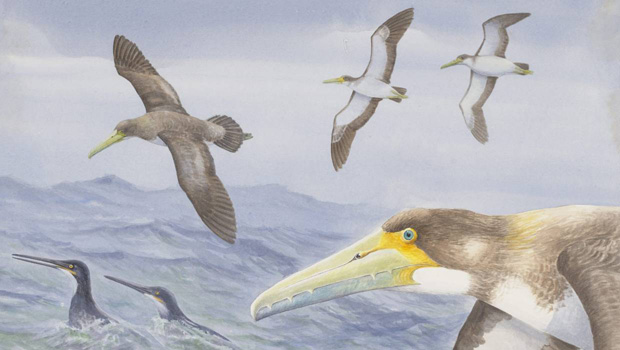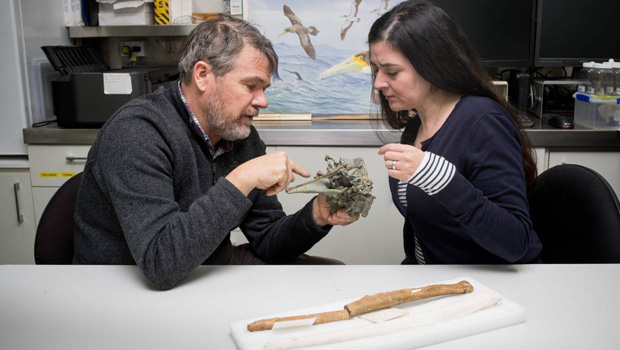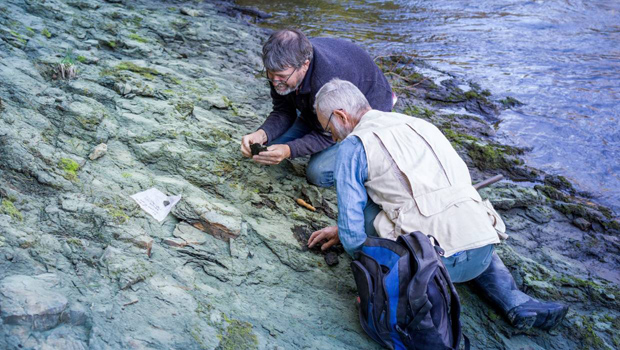Scientists discover one of the oldest “toothed” bird species in the Waipara Greensands
The remarkable fossil site located on the banks of the Waipara River north of the town of Canterbury on New Zealand’s South Island has provided palaeontologists with an amazing record of life during the Palaeocene Epoch, when the climate of New Zealand was very different than it is today.
Protodontopteryx ruthae
Soaring above the tropical coastline some 62 million years ago was a gull-sized, bony-toothed bird which has been named Protodontopteryx ruthae. Classified as a member of the Pelagornithidae, a family of huge seafaring birds, characterised by bony outgrowths along their jaws that served as teeth, the discovery of Protodontopteryx suggests that these birds originated in the Southern Hemisphere and not in the Northern Hemisphere as previously thought.
A Life Reconstruction of the Newly Described Pelagornithid Protodontopteryx ruthae

Picture credit: Derek Onley
The Oldest and Smallest Member of the Pelagornithidae to be Described
Writing in the journal “Papers in Palaeontology”, the research team, which included scientists from Canterbury Museum, describe Protodontopteryx which is oldest member of the Pelagornithidae to be described to date. It is one of the oldest named Neornithes (modern birds), known to science.
Examining the Fossil Remains of P. ruthae

Picture credit: Canterbury Museum
While its descendants were some of the biggest flying birds ever, with wingspans of more than 5 metres, Protodontopteryx was only the size of an average gull. Like other members of its family, the seabird had bony, tooth-like projections on the edge of its beak.
Its discovery provides further evidence of the remarkable biota that existed in this part of the world just a few million years after the Cretaceous mass extinction event that saw the demise of the non-avian dinosaurs. Recently, Everything Dinosaur team members blogged about another bird fossil excavated from the Waipara Greensand, a giant 1.6 metre high prehistoric penguin: Monster Penquin from the Palaeocene of New Zealand.
Discovered in 2018
Amateur palaeontologist Leigh Love found the partial Protodontopteryx skeleton last year at the Waipara Greensand fossil site. The bird was named Protodontopteryx ruthae after Love’s wife Ruth, a token of his appreciation for her tolerance and support as he pursued his decades-long passion for fossil collecting. Fellow amateur Alan Mannering prepared the bones, and a team comprising Love, Mannering, Canterbury Museum Curators Dr Paul Scofield and Dr Vanesa De Pietri and Dr Gerald Mayr (Senckenberg Research Institute and Natural History Museum in Frankfurt, Germany), described Protodontopteryx.
Commenting on the implications regarding the likely origin of pelagornithids Dr Scofield stated:
“While this bird was relatively small, the impact of its discovery is hugely significant in our understanding of this family. Until we found this skeleton, all the really old pelagornithids had been found in the Northern Hemisphere, so everyone thought they’d evolved up there. New Zealand was a very different place when Protodontopteryx were in the skies. It had a tropical climate – the sea temperature was about twenty-five degrees [Celsius] so we had corals and giant turtles.”
An Unexpected Discovery
Dr Mayr added that the discovery was:
“Truly amazing and unexpected. Not only is the fossil one of the most complete specimens of a pseudotoothed bird, but it also shows a number of unexpected skeletal features that contribute to a better understanding of the evolution of these enigmatic birds.”
Later pelagornithid species evolved to soar over oceans with some species having wingspans in excess of six metres. Protodontopteryx’s skeleton suggests it was less suited for long-distance soaring than later pelagornithids and probably covered much shorter ranges. Its short, broad pseudoteeth were likely designed for catching fish. Later species had needle-like pseudoteeth which were likely used to catch soft-bodied prey like squid.
The Fossil Site where the Remains of Protodontopteryx was Discovered

Picture credit: Canterbury Museum
Dr De Pietri added:
“Protodontopteryx was less adapted to sustained soaring than other known pelagornithids, we can now say that pseudoteeth evolved before these birds became highly specialised gliders.”
Protodontopteryx ruthae a Basa; Pelagornithid
These types of bird once dominated the oceans of the world, but the last of their kind died out some 2.5 million years ago. A number of fossil discoveries from the remarkable Waipara Greensand will be put on display at Canterbury Museum, in a new exhibition tracing the evolutionary history of the fauna and flora of New Zealand. The exhibition is due to open later this year.
Everything Dinosaur acknowledges the assistance of a press release from Canterbury Museum in the compilation of this article.
The scientific paper: “Oldest, Smallest And Phylogenetically Most Basal Pelagornithid, From The Early Paleocene Of New Zealand, Sheds Light On The Evolutionary History Of The Largest Flying Birds” by Gerald Mayr, Vanesa L. De Pietri, Leigh Love, Al Mannering and R Paul Scofield published in Papers in Palaeontology.
Visit the Everything Dinosaur website: Everything Dinosaur.






Leave A Comment